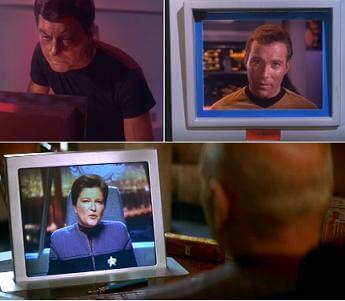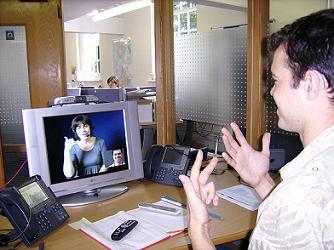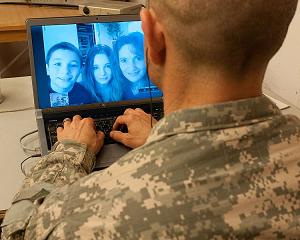Why Don’t We Video Chat More Often?

Share
One of the most common staples of any futuristic movie or book has always been the video (or even holographic) phone call. From Back to the Future to Star Trek, it seems as though people in the future are always chatting it up in style. So why is it then, that most of us use video chat so rarely today?
Ten years ago if someone had told you that in 2011 everyone would have a webcam in their home or in their pocket, and that the cost of video chat was going to be zero, how many of us would have predicted that people still wouldn't use it? I certainly would not have predicted such an outcome, yet this is exactly what has happened. A recent report from the Pew Research Center documents just how little video chat is used. According to Pew, only 1 in 5 Americans have ever tried video calling over the internet, and less than 1 in 10 Americans have tried video calling on their phones. This is in spite of the fact that webcams are everywhere around us!
In a quick search on Dell.com, I was unable to find a single laptop for sale that didn't come with a built-in webcam. Even the cheapest laptop I could find on Dell (an Inspiron Mini 1018 costing just $279) comes with a webcam standard. iphones and soon android phones offer video chat capability, and hundreds of millions of desktop computers are webcam enabled. And to top it all off, the cost of video chat is usually free!
I have a video chat enabled iphone, I have a webcam enabled laptop and a webcam enabled desktop computer at home. I send dozens of emails and make dozens of phone calls per day. Yet I only perform video calls perhaps twice a week, and this puts me easily in the top 1% of society - most people rarely, if ever, take part in social video calls.
So what's going on here? What did the futurists get wrong? Do people really prefer to converse without looking at each other? Is chatting over email or voice without the visual component actually more appealing for human interaction, or is there some other underlying explanation?
Many would say that the poor quality of the video chat experience deters them from using it. The image can be spotty, the call often gets dropped. But does poor quality really impact our use of video that much? When making voice calls with AT&T, I can expect one out of three calls to drop on average each day. I curse AT&T daily for this outrage, but I keep on using them anyway, and so do tens of millions of Americans. AT&T seems to prove that people get angry about poor call quality, but it doesn't really stop them from making the calls anyway.
Many people that I asked recently pointed to convenience as the culprit. It is too hard to coordinate a video call, they would say, too much of a pain to setup and initiate. But is that really true? In my gmail chat window right now I can see video icons next to the names of roughly a dozen of my friends that are at their computers right now, logged into gmail at the same time as me, and literally one click away from joining me in a video chat. But guess what? We never click that button. My wife and I both have iphones and can setup flawless wifi video chats by pushing one button on our phones, but we rarely use this feature. I don't think it can get much better than "one click" for convenience.
So if convenience isn't to blame, and video quality isn't to blame, then what is going on here? It seems the true culprit actually comes down to the under appreciated complexities of human social interaction. When you initiate a text or voice chat with someone, you don't worry about interrupting them because there is a very high probability that they are in a position to answer. Whether we are in the car, cooking in the kitchen, taking it easy in the bathroom, or even talking to another person, most of us are still willing to take a text or voice chat. Add video to the mix, however, and all of this changes. By adding video, we are asking the person to let us see them, and we are requiring more of their attention. No longer can they drive and chat with us if they have to look at a video. No longer can they talk in the bathroom or at other times when they are doing their personal business. No longer can they discretely interact with you while simultaneously talking to another person, reading a magazine, or otherwise only paying half attention to you. Adding video to the situation completely changes the social dynamic, usually in a way that makes us not want to do it.
Another barrier to the successful video chat is that a lot of the time we just don't want to have a big, long conversation. Video chats send a social signal to the person that you want to have a "real" conversation with them. If you just want to call someone to ask "what time the party is at" or "where the keys are" you aren't going to setup a video chat and risk getting dragged into a long video conversation. In these cases a text or voice chat is more desirable. In fact, all too often when making a phone call, I hope the person doesn't even answer so that I can leave a voice message with the pertinent information and get on with my day. With today's video chat, it usually isn't even possible to leave a video message. Video chats are for longer, dedicated chats, and most of the time this just isn't what we want.
Be Part of the Future
Sign up to receive top stories about groundbreaking technologies and visionary thinkers from SingularityHub.


So is the future of long distance human communication destined to remain video-less. Or were the futurists right, and someday soon we will all be looking hip and awesome on video chat?
Video chat is just one part of an entire arsenal of communication possibilities at our disposal. Email, voice chat, text chat, Facebook pokes and updates, Twitter updates, and video chat are all part of that arsenal. Each of these communication options is useful for different situations, depending on how long we want the conversation to be, and depending on how many people and which people we want to communicate with. Video chat is not going to dominate our lives as the only form of communication, but video chat is nevertheless an awesome part of your communication toolkit. Too many people are neglecting to use this tool, and they are sorely missing out on a great experience.
I use video chat regularly when communicating with remote coworkers. In the past these conversations would be voice only, but by adding video to the mix our interaction is so much more vibrant and meaningful. When it comes to communicating with people that you rarely get to see in person because they are hundreds or even thousands of miles away, video can be an invaluable tool for nurturing and enhancing those personal or work related relationships.
If you are like most people out there, you rarely if ever take part in video conversations with friends, family, and coworkers, yet you probably have access to a webcam readily available. If you are one of these people, I highly recommend you give it a try and see what you are missing. With skype, gmail, or even your smartphone, setting up a video chat is usually as simple as making a single click! Just yesterday while writing this story I decided to have some fun by randomly initiating video chats with people that my gmail interface indicated were online and available for video chat. It was a total blast! The individuals on the other end got a kick out of the random event, and the conversations were so much more meaningful than the typical voice chat usually is.
Although video chat is still used rarely by most of us today, the trend suggests that more and more of us are taking advantage of the once futuristic capability every day. According to the same report from Pew, video chat usage by Americans doubled from 2009 to 2010. I wouldn't be surprised if several more doublings aren't in store for us in the coming years. As one might expect, Pew says that "Younger internet users are considerably more likely to conduct video calls." Old or young, however, that webcam right next to you is waiting to be used. Go for it!
[Star Trek Image Credit: trekmovie.com]
[Image Credit: [GFDL, via Wikimedia Commons]
[Image Credit: via Wikimedia Commons]
Related Articles

This Portable Wind Turbine Is the Size of a Water Bottle and Charges Devices in Under an Hour

Mojo Vision’s New Contact Lens Brings Seamless Augmented Reality a Step Closer
The Weird, the Wacky, the Just Plain Cool: Best of CES 2020
What we’re reading



